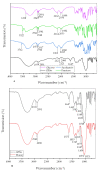Honey and Its Biomimetic Deep Eutectic Solvent Modulate the Antioxidant Activity of Polyphenols
- PMID: 36358566
- PMCID: PMC9686586
- DOI: 10.3390/antiox11112194
Honey and Its Biomimetic Deep Eutectic Solvent Modulate the Antioxidant Activity of Polyphenols
Abstract
Honey is a highly valued natural product with antioxidant, antimicrobial and anti-inflammatory properties. However, its antioxidant activity (AOA) is not as high as that of other honeybee products, such as propolis. Several polyphenol-honey formulations have been proposed up to now, most of them using maceration of biomass in honey or mixtures with liquid extracts, which either limit polyphenols bioavailability or destroy the characteristics of honey. To improve the health benefits of honey by increasing AOA and keeping its structural and sensory properties, we propose its enrichment in a polyphenol extract of raspberry after solvent evaporation. A honey-biomimetic natural deep eutectic solvent (NaDES) was prepared and compared with honey. The main polyphenols found in the raspberry extract were tested in combination with honey and NaDES, respectively. The AOA was determined by DPPH, ABTS, CUPRAC, and FRAP methods. The AOA behaviour of honey-polyphenol mixtures varied from synergism to antagonism, being influenced by the AOA method, polyphenol type, and/or mixture concentration. The honey-biomimetic NaDES resulted in similar AOA behaviour as with honey mixed with polyphenols. Honey seems to have additional properties that increase synergism or reduce antagonism in some cases. Honey and its biomimetic NaDES modulate AOA of polyphenols extract.
Keywords: antagonism; antioxidant activity; biomimetic NaDES; honey; natural deep eutectic solvent (NaDES); polyphenol-enriched honey; polyphenols; raspberry extract; synergism.
Conflict of interest statement
The authors declare no conflict of interest.
Figures











References
-
- El Achkar T., Greige-Gerges H., Fourmentin S. Deep Eutectic Solvents for Medicine, Gas Solubilization and Extraction of Natural Substances. Springer; Berlin, Germany: 2021. Understanding the Basics and Properties of Deep Eutectic Solvents; pp. 1–40.
-
- Postali E., Peroukidou P., Giaouris E., Papachristoforou A. Investigating Possible Synergism in the Antioxidant and Antibacterial Actions of Honey and Propolis from the Greek Island of Samothrace through Their Combined Application. Foods. 2022;11:2041. doi: 10.3390/foods11142041. - DOI - PMC - PubMed
Grants and funding
LinkOut - more resources
Full Text Sources
Miscellaneous

